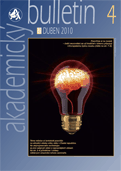17 Jul 2014

Last step before full genome sequence
The International Wheat Genome Sequencing Consortium (IWGSC) published today in the international journal Science a draft sequence of the bread wheat genome. The chromosome-based draft provides new insight into the structure, organization, and evolution of the large, complex genome of the world’s most widely grown cereal crop. The genetic blueprint of the wheat genome was obtained using the chromosome-based strategy developed by research team of Jaroslav Doležel, Professor at the Institute of Experimental Botany AS CR.
11 Jul 2014

A current trend of modern biomedical research is the attempt to minimalize experiments on animals like mice or chickens and where it is possible to replace them with developmentally simpler model organisms, but it is a necessary precondition that some basic cellular and physiological processes are evolutionarily conserved with these organisms, by which the similarity with the processes taking place in more complex organisms is preserved. One such biological model is the aquarium fish, the zebrafish, named for its zebra-like stripes.
4 Jun 2014

Scientists working to understand the devastating bat disease known as white-nose syndrome (WNS) now have a new, non-lethal tool to identify bats with WNS lesions —ultraviolet, or UV, light. If long-wave UV light is directed at the wings of bats with white-nose syndrome, it produces a distinctive orange-yellow fluorescence. This orange-yellow glow corresponds directly with microscopic skin lesions that are the current “gold standard” for diagnosing white-nose syndrome in bats.
12 May 2014

One of the major transformations of the planet from human activities is the wholesale redistribution of species, through the deliberate or accidental translocation of their populations to areas outside their native range. These “alien” species have in many cases caused substantial deleterious impacts to the recipient environment (e.g. extinctions of native populations and species, the disruption of soil nutrient and water cycling, and natural disturbance regimes). Preventing and mitigating such impacts is a major drain on limited conservation resources.
12 May 2014

Scientists from the Institute of Molecular Genetics of the Academy of Sciences in Czech Republic (IMG), in collaboration with several leading centers in the USA and the Netherlands, clarify the mechanism of transformation in one subtype of leukemia. Importantly, they identify substances that in a future might help to develop more effective treatments for this disease. The results of this study were published in the international journal Haematologica.
22 Jan 2014

On Tuesday, 21st of January, 2014 Nikon Company in the cooperation with the Institute of Molecular Genetics, Czech Academy of Science, will start operation of a new Nikon Centre of Excellence in Super Resolution Microscopy. The Super Resolution Microscopy is a revolutionary microscopic method enabling the observation of the smaller details especially in the cell biology, than it was possible until now with the conventional methods.
28 Nov 2013

Humanity is dependent on natural ecosystems as sources of food, but they also provide other essential services. The preservation of biological diversity is a fundamental challenge for contemporary environmental protection. Recent research has found that intraspecific diversity plays an equally vital role in the functioning and stability of ecosystems as interspecies diversity. Intraspecific diversity was until now always attributed to phenotypic and functional diversity of individuals, secured thanks to the variability of DNA. Nevertheless, the phenotype is controlled only by the base sequence of nucleotides in the DNA, but is also controlled by epigenetic variation.
25 Nov 2011

New knowledge from biologists of the ASCR
The Common Cuckoo is an obligatory brood parasite that lays its eggs in the nests of other bird species (hosts), and leaves them with the entire burden of raising their offspring. As a consequence of this way of life, a number of specific adaptations have arisen, to which the hosts respond with adequate counteradaptations. That leads to the emergence of a coevolutionary struggle between the two involved parties. One of the most interesting adaptations of the Common Cuckoo is the often noteworthy similarity of their eggs to the hosts’ eggs (mimicry), which increases the chance that the host does not recognise and remove them.
6 Nov 2013

Copenhagen 6 November 2013: The 7th annual SHARE Symposium in Copenhagen, Denmark on 6 November 2013 has the pleasure of welcoming two keynote speakers. In the morning Professor Bente Finsen, University of Southern Denmark, gives a presentation on “Understanding disease mechanisms in human neurological disorders through studies of mice”, and in the afternoon Professor Helena Tlaskalova-Hogenova, Academy of Science of the Czech Republic, gives a presentation about “The role of microbiota in the immune system development and chronic disease”.
24 Sep 2013

Opening of a top centre
A research centre with the latest equipment at the top European level – CZ-OPENSCREEN: National Infrastructure for Chemical Biology –was ceremonially opened today at the complex of the Academy of Sciences of the CR in Krč in Prague with Minister of Education, Youth and Sports Dalibor Štys in attendance. The unique scientific workplace was created within the framework of the Institute of Molecular Genetics of the ASCR and is focused on basic research in the area of chemical biology and genetics. Researchers will seek new chemical compounds that will be used as the basis for the development of new medications or as an instrument for more detailed understanding of cellular processes. For more information, see the
press release.
19 Sep 2013

A new function of the
HOPX gene, which places it among the not very numerous group of genes responsible for the change of the cell of the primary tumour into a metastatic cell, was described by a scientific team at the Institute of Molecular Genetics of the ASCR led by Dr. Jiří Hejnar. Their discovery was published in August this year in the international journal Molecular Cancer Research (see
abstract). It is a generally known fact that in tumour illnesses the main cause of death in patients are precisely metastases, the secondary centres of the tumour scattered in distant organs and tissues, which resist surgery, radiation and are not very sensitive to chemotherapy.
5 Sep 2013

The killifish of the genus of
Nothobranchius – small annual fishes from the savannahs of East Africa– are real record-breakers. Their extremely short life is connected with the fastest sexual maturation of all vertebrates. This significant discovery by scientists from the Institute of Vertebrate Biology of the ASCR in Brno has now been published in the international journal EvoDevo as a component of its articles on life in extreme conditions (see the
abstract). The investigation of killifishes living in savannah pools created during the seasonal monsoon rains.
4 Sep 2013

Early farmers had already brought the field vole to the Orkney Islands north of Scotland 5100 years ago by boat, most likely from the coast of today’s Belgium, and so maintained the genetic diversity that disappeared from Europe. These conclusions highlight research of an international team of scientists led by the University of Aberdeen (United Kingdom) and Cornell University (USA), which was published on Tuesday, 3 September 2013 in a major professional journal Molecular Ecology (see the
abstract). Also researchers from the Institute of Vertebrate Biology of the Academy of Sciences of the CR were involved in one of the most extensive studies of its type.


















